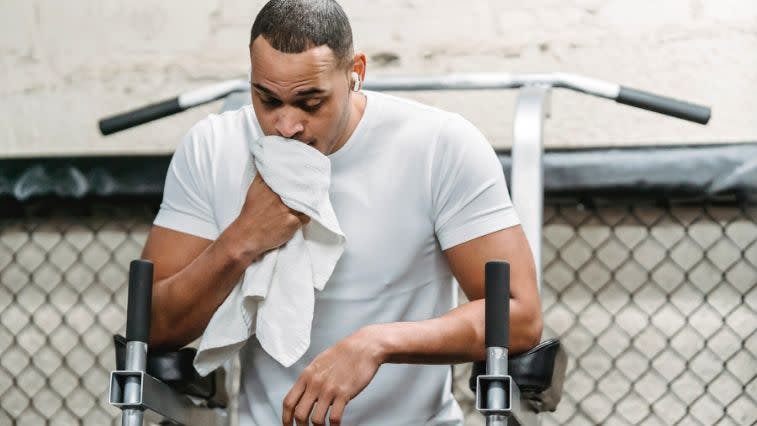How to Rebuild Your Stamina and Energy After COVID-19
Our content strives to support, inform, and motivate you to meet your health goals. We want to be your trusted source of expert- and science-backed info dispensed in simple, actionable ways. Read our Editorial Guidelines.
COVID-19 can leave lingering effects long after an infection has cleared enough for you to return to your daily activities. Many people feel drained, as though their energy levels are far below normal.
For my clients, friends, and family members who’ve had COVID-19, the length of time this lasts and the degree of these effects vary widely from person to person. Likewise, the time and effort it takes to recover your stamina after COVID-19 will be unique to you. Here is more about returning to physical activity and tips for rebuilding your stamina after a bout of COVID-19.
When It’s Safe to Return to Activity
“Generally speaking, for those individuals with mild to moderate illness that did not require hospitalization, it’s recommended to wait at least 10 days after onset of symptoms and 24 hours after being fever-free without the use of antipyretics or NSAIDs,” explains Chris McDermott, advanced practice registered nurse with Autonomous Practice (APRN-IP) in Florida, who has a clinical background in pulmonary, critical care & sleep medicine.
For those with a severe illness that required hospitalization, it can take longer before it’s safe to resume physical activity, he says. “One should work closely with their healthcare provider or physical therapist to determine the appropriate timeline,” says McDermott.
Returning to Activity After Covid-19

When you’re recovering from an illness or injury, typically, the best judge of when it’s time to resume “normal” activities and at what level of intensity is yourself, according to Rand McClain, MD, regenerative and sports medicine doctor. “Listen to your body sounds cliche, but I have found that at least 80% of the time, the patient knows when and how to get back in the game after a setback,” he says.
I’ve found for myself and clients that the only way to really tell if you’re ready to return to activity or increase intensity is to test how your body responds. Two of the most common complaints I’ve heard after COVID-19 are fatigue and shortness of breath.
Regarding fatigue, Dr. McClain recommends resuming your normal activities and observing whether recovery and energy levels improve gradually over successive days. He explains that most of his patients eventually recover completely, albeit at different rates.
I’ve found the same to be true of my clients and myself.
But, if the recovery trend begins to stall or seems to be going backward, evaluate the possible reasons with your physician. “COVID-19 tends to cause considerable inflammation and can ‘settle into’ different organs in certain individuals,” warns Dr. McClain.
One of the notable hindrances to recovery after COVID-19 is damage to the heart and/or the tissue surrounding the heart called the pericardium.
“Inflammation caused by this myocarditis and/or pericarditis is a relatively common sequela specific to COVID-19,” he says. Myocarditis and pericarditis typically resolve within 90 days.
Still, according to Dr. McClain, you don’t want to push yourself during the healing period because it can exacerbate the condition and lead to more damage that could possibly be permanent. Of course, you should see your doctor for clearance to return to exercise, especially if you’re not progressing.
How to Increase Activity to Build Stamina When You’re Ready
Some clients have felt like catching their breath is more challenging than before. This feedback is crucial, and you should listen to your body. Getting enough oxygen through your lungs and working muscles is vital. I typically suggest a slow, gradual warm-up to help the body adjust to more work.
Even with weight lifting, you must have enough work capacity and cardiovascular fitness to push through your sets. Many people end up not fully working the intended muscle group but stopping when out of breath, limiting the workout's effectiveness. Dr. McClain agrees, suggesting gradually challenging yourself daily to do more and more of what you could do prior to infection.
So, if you’re a runner, try some short, easy runs to start and gradually build up your time and intensity over a few weeks. Keep a record of your progress and listen to your body. If lifting weights is your preferred workout, try some movements you know well and are good at.
See how your body responds in terms of the reps you can do. Keep track of how sore your muscles feel and how you recover. Add more sets, reps, or weight gradually over several weeks and ensure you take rest days.
Keep in mind that the more advanced your fitness level was before illness, the longer it might take to return to your top form. Advanced athletes show a fairly significant drop in performance after having COVID-19. It’s important to go easy on yourself and keep the big picture in mind: You will very likely return to your top form, but a slow and steady increase in progress is best.
Activating Your CNS for Energy After COVID-19

After a break from your normal workout routine, your central nervous system (CNS) may be a bit sluggish, and this could make you feel even more fatigued. If you struggle to get back into the mood and feel energized, a warm-up targeting your CNS will help.
Your nervous system will send messages to and from your organs, muscles, and brain, helping signify to your brain and body to use energy for movement. Warm-ups that gradually increase your heart rate and breathing and activate your CNS are ideal. They will help to rebuild stamina after COVID-19, prevent injury, and improve performance.
Try this warm-up before your workout. You can adjust the times based on your current fitness level:
60 seconds walking
20 seconds of jogging in place
20 seconds of gentle hops
20 seconds bigger jumps
10 seconds explosive jump squats
Repeat the squats, jumps, and hops in reverse order
How to Keep Improving Your Stamina
To keep progressing and rebuilding stamina and energy after COVID-19, monitor your progress and listen to your body. If you’re feeling increasingly tired or symptoms are worse, you should back off and add more rest. It’s also wise to see a doctor for advice.
If you’re feeling good, my clients tend to return to their previous fitness level in a couple of months. Ensure you get plenty of rest and recovery time, eat and hydrate well, and warm-up thoroughly before you work out.
Basic Plan to Rebuild Stamina After COVID-19

Putting it all together, here are the main takeaways from this article that will help you rebuild your stamina and energy, with advice from myself, Dr. McClain, and McDermott.
Begin with low-intensity exercises such as yoga or walking that gradually increase in intensity and duration.
Aim for small, achievable goals rather than jumping back into a pre-COVID exercise routine.
Listen to yourself and your body before and after exercise. It’s best to stop and rest if you feel excessively tired or short of breath.Allow plenty of time to recover between exercises.
Work with a qualified trainer or physical therapist to develop an effective and realistic exercise plan based on your current health status and individual needs.
Stay hydrated and practice good nutrition. Both are essential for building stamina and recovering after COVID-19. Drink plenty of pure water, and include various vegetables and proteins to provide nutrients to reset the cells’ optimal function.
After you test negative or get cleared by your doctor to exercise, get a free consultation with a personal trainer, who can create a customized stamina-building program for you.